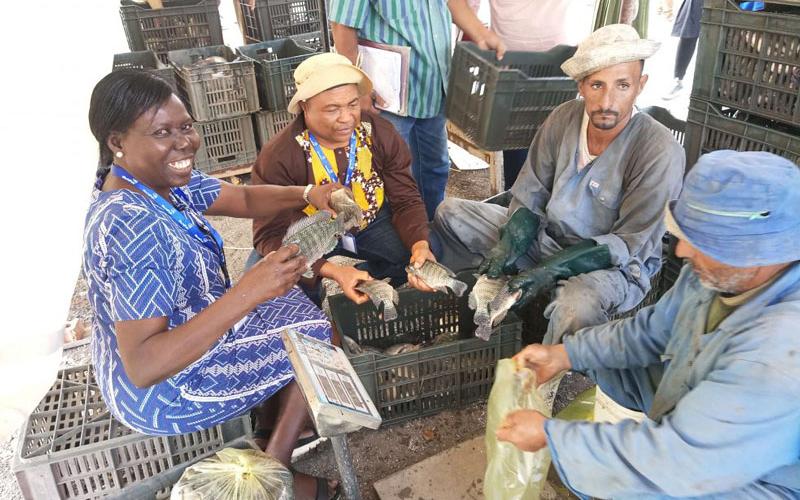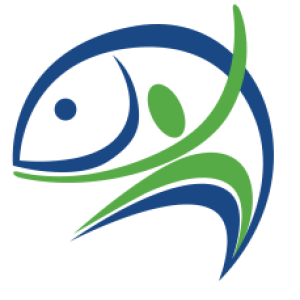
WorldFish is a global leader in aquatic food systems research and innovation for healthy people and planet. Science and partnerships are the foundation of our work. Our team delivers robust evidence to policymakers and technological innovations to producers, value chain actors, and consumers in order to transform food systems. In this series, we feature our scientists in the spotlight, veteran researchers who have made a significant contribution to their field.
WorldFish is a global leader in aquatic food systems research and innovation for healthy people and planet. Science and partnerships are the foundation of our work. Our team delivers robust evidence to policymakers and technological innovations to producers, value chain actors, and consumers in order to transform food systems. In this series, we feature our scientists in the spotlight, veteran researchers who have made a significant contribution to their field.
Bernadette Fregene is WorldFish’s aquaculture compact leader and a professor of aquaculture and fisheries extension, economics, and marketing at the University of Ibadan in Nigeria. Fregene facilitates the delivery of new technologies to aquaculture producers, aiming to increase local production of aquatic foods, improve household nutrition, and create job opportunities for women and youth. In her role, she manages interventions along the aquaculture value chain to develop the capacity of small-scale fish farmers.
What are you currently working on for WorldFish?
I am working with WorldFish to lead the Aquaculture Compact, which is one of the commodity groups of the Technologies for African Agriculture Transformation (TAAT) program funded by African Development Bank. The aim is to boost productivity by scaling agricultural innovations and making Africa self-sufficient in key commodities, such as aquatic foods, maize, wheat, and rice.
I assist with scaling-up aquaculture production in West, East, South, and Central Africa, and I am currently involved in the deployment of aquaculture innovations and technologies to aquaculture value chain actors. These include the production of quality monosex tilapia and catfish seed, development of low-cost fish feed using locally available materials, improved fish rearing methods, and value-added fish products from smoking kilns and solar-tent drying. The technologies are disseminated through capacity development, promotional campaigns, on-farm demonstrations, and extension manuals.
As a social economist, I work to link WorldFish with its local partners through the coordination of projects. I manage and coordinate project implementation in 12 African countries: Benin, Burundi, Cameroon, Cote d’Ivoire, DR Congo, Ghana, Kenya, Malawi, Nigeria, Tanzania, Togo, and Zambia.
What’s the most exciting thing about your research area?
I’m excited about the adoption of new technologies for quality monosex tilapia seed, low-cost fish feed, and fish value addition by our partners in Africa. It is challenging for farmers in many African countries to access quality fish seed, which limits the sustainability and efficiency of production. Expanding aquaculture and boosting the production of fish seed, via the identification and deployment of appropriate technologies, can advance food security and gender equity—providing rural areas with nutrient-rich aquatic foods and creating employment opportunities for women along the value chain.
The TAAT Aquaculture Compact has already disseminated 13 WorldFish technologies to assist small-scale aquaculture farmers and promote aquaculture development. There has been a high rate of adoption of aquaculture technology by fish breeders, farmers, and processors. A total of 97 demonstration sites have been established in our partner countries, impacting over 20,000 aquaculture value chain actors, and more than 150 million fingerlings have been produced as part of the project—delivering nutritional and monetary gains.
What technological innovation has the greatest potential to boost aquatic food production in Nigeria?
Aquaculture production will be enhanced with future technologies that can increase the diversification of fish species, offering fish with accelerated growth rates that generate faster revenue to the farmers and investors. A better-integrated production system will also increase efficiency along the value chain and generate income throughout the year.
The In-Pond Raceway System (IPRS) has the greatest potential for higher productivity and profitability via sustainable intensification. IRPS systems concentrate fish in cells or raceways to improve feeding efficiency, maintain water quality, and reduce solid waste.
How can aquaculture producers be better supported?
Approximately 50 percent of aquaculture producers in Nigeria are small-scale, but aquaculture is capital intensive. There need to be more opportunities for small-scale producers to be members of value chain actors’ associations or cooperatives to receive loans and more targeted investments from credit institutions.
Fish feed is the most expensive input in farming operations because most feed is branded and imported. We are working to educate farmers on cheap local resources that can be used to produce fish feed like energy-rich cassava peels and protein-packed soybeans to lower their production costs. Since Nigeria is the largest producer of catfish in Africa, we have developed high-quality catfish seed and our own indigenous techniques to create low-cost fish feed.
What is the role of women in aquaculture value chains?
Aquaculture offers lucrative job opportunities for women, but there are gender disparities in the function of actors along aquaculture value chains. Women primarily work as fishmongers, processes, or retailers. With TAAT, we are integrating women into more diverse occupations along the value chain and training them to be self-sufficient farmers. Currently, only around 10-20 percent of women are fingerling producers with their own ponds. We are working to support women as producers of tilapia and catfish seed to better incorporate them into the formal economy.
What piece of your scientific research are you the most proud of?
I am proud of the production of new extension manuals that can easily be adopted by aquaculture value chain actors in Africa, in the areas of monosex tilapia production, catfish seed production, quality low-cost fish feed formulation and production, fish value addition, and fish recipes. In 2021, these manuals will be translated into French, Portuguese, and some local African languages to further increase their accessibility.
These extension manuals allow us to reach low-income small value chain actors, who can now learn of quality fish seed production, ways to harness local materials for fish feed production, and methods to add value to their fish products. The manuals are written in easy-to-read English language, allowing them to be used along the value chain by hatchery operators, fish feed producers, fish farmers, fish processors, restaurant operators, and consumers.
What do you hope your research ultimately achieves?
I hope my research leads to improved technology awareness and adoption by aquaculture value chain actors, creating new jobs and opportunities for marginalized groups. Through my work, I wish to empower women and youth, strengthen food security, and reduce poverty in rural areas. I aim to disseminate technologies to those who need them most in support of sustainable and resilient livelihoods.
